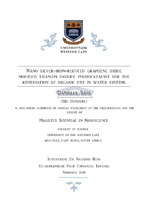| dc.contributor.advisor | Ross, Natasha | |
| dc.contributor.author | Sass, Danielle Thandi | |
| dc.date.accessioned | 2018-09-18T10:48:35Z | |
| dc.date.available | 2021-12-31T22:10:04Z | |
| dc.date.issued | 2018 | |
| dc.identifier.uri | http://hdl.handle.net/11394/6410 | |
| dc.description | Magister Scientiae - MSc (Chemistry) | |
| dc.description.abstract | Drinking water with high concentrations of inorganic and organic contaminants can cause
adverse health defects. Specifically methyl orange dye is an organic water contaminant that has
been known (along with others like methyl blue etc.) to have an increase in our water systems
over the past few years due to increasing demand in industrial processes. It is therefore of
utmost importance to remediate organic contaminants and ultimately enable prevention. The
contaminants can be removed by photocatalysis. Anatase TiO2 is known for its photocatalytic
degradation of environmental pollutants and photoelectro-chemical conversion of solar
energy. However its application is limited since it is a wide band gap semiconductor, (Eg = 3.2
eV). The following study deals with the enhancement of the photocatalytic properties of TiO2
for remediation of organic water contaminants. | |
| dc.language.iso | en | |
| dc.publisher | University of the Western Cape | |
| dc.subject | Photocatalysis, Titanium Dioxide, Nanocomposite, Silver-Iron, Methyl orange/Orange II dye, Photocatalytic study, Band gap | |
| dc.title | Nano silver-iron-reduced graphene oxide
modified titanium dioxide photocatalyst for the
remediation of organic dye in water systems | |
| dc.rights.holder | University of the Western Cape | |

